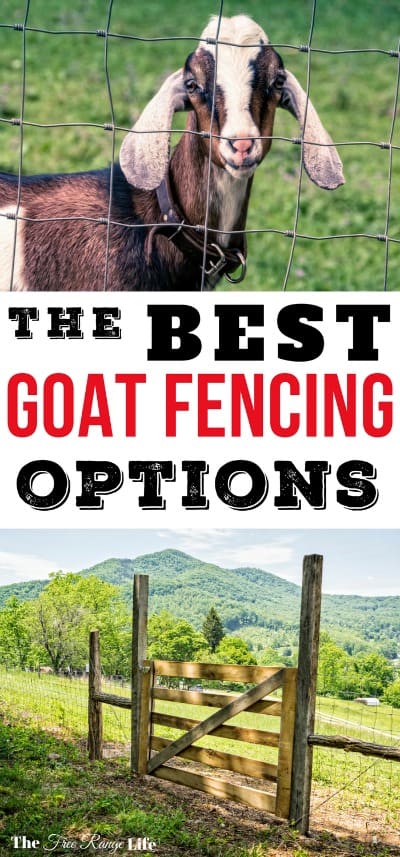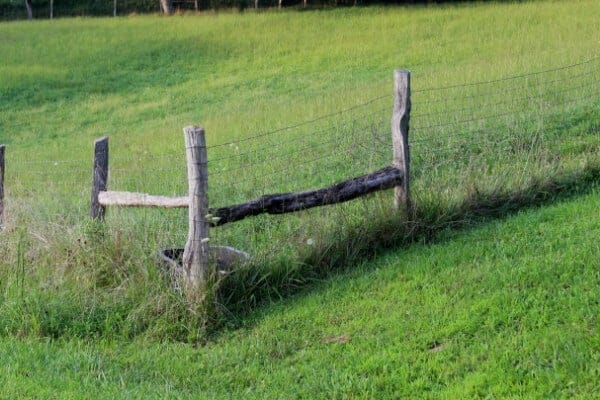Looking for information on making your goat yard? Here’s your complete guide to goat fencing and all the best options to contain your goats right where you want them!
I still remember the day I realized just how stubborn goats can be— and how important good goat fencing is. Our 5 month old Saanen does were in their yard and the kids and I were playing out back. The 2 does were feeling frisky and running and jumping all around. Bella, who we quickly learned would test any and all fences, got a good running start and jumped right over our 4ft tall chain link fence.
This site contains affiliate links. If you make a purchase using one of these links, I may earn a commission. Please see my disclosure page for more information about cookies collected and our privacy policy.
It was the only time she tested the chain link- but the welded wire that separated the goats from the dogs was pushed down soon after. Moral of the story- build good goat fences from the very beginning!
Goats are notorious for testing fences, so when you plan your pastures make sure that your fencing is strong!
- Make your goat fences tall. Some goats love to jump. 4 ft is the minimum height you should have.
- Choose wire that can withstand climbing and leaning (ie. woven wire NOT welded wire)
- Choose wire that your goats can’t get their heads stuck through- especially those with horns.
- You may need a combination of wire and electric to keep some goats contained.
On our farm we use a combination of 4-strand electric wire and woven goat fencing. It works well for us and we only occasionally have escapees. Here are some of the pros and cons of those two options.
The Best Options for Goat Fencing
4-5 Strand Electric:
We currently have a large pasture using 5 strands of electric fencing. It works well for the does and babies and even the boys when it’s not breeding season.
Pro: It is Simple and inexpensive to construct. We have a mountainous and wooded pasture where putting up woven wire would be a nightmare. T-posts and electric was a breeze!
Pro: Most goats won’t pass this psychological barrier- but they can sense when it is down!
Con: In the summer, weed trimming must be done often so that it won’t ground out. You need to walk the fence row often to check for fallen limbs and such.
Con: It won’t always work for bucks in rut- you need a physical barrier to keep them where you want them to be.
If you are new to goats, I recommend reading up as much as you can before you purchase. You can find a lot of articles here on The Free Range Life that will teach you about goat care and be sure to check out The Busy Homesteader’s Goat Management Binder– it’s full of to-do lists, checklists, record keeping sheets, and resource pages that will get your new goat herd off to a great start!
Goat Wire (4-inch squares):
We currently use woven goat fencing with 4 inch opening in our buck yard and large open pasture.
Pro: It is strong enough for goats to lean on without pushing it down- provided that you pulled it tight when putting the fence up.
Pro: Adult goats cannot put their heads through the openings.
Con: Young kids- especially those with horns- can fit their heads through and will get stuck. This is usually short lived as kids grow fairly quickly.
Con: The standard 4 ft height might not be tall enough for jumpers like Nigerian Dwarf or large breeds (like my Saanen). This can be remedied by adding one additional strand of electric wire above the wire goat fencing.
Other Fencing for Goats
The following options are okay for goats, but not as good as the goat wire and electric I talked about above.
Woven Field Fence
This is still woven wire, so it is still durable, but it is a thinner fencing that might not be as strong when it comes to goats standing or leaning on it.
The holes are also larger, so goats- especially those with horns- can get their heads stuck.
Field fence is less expensive than goat fencing, so if cost is an issue, it is a good alternative.
Cattle Panels
Cattle panels are very strong fence panels. They come in 16-ft sections and are very durable.
It would be very expensive to fence a large pasture with these panels, but they are good for small yards, dividing pastures, making corrals, etc.
True cattle panels also have larger openings, so goats can get stuck, and we’ve even had babies escape through them. They do make goat panels which have the smaller 4×4 sized openings.
The following are goat fencing options that I do not recommend:
Any welded wire fencing. It is just not strong enough to withstand everything a goat will put it through. The welded connections tend to break much more easily and it can get pushed down by goats when they lean or stand on it.
Fencing for goats can be an overwhelming job, if you are still confused as to what to build, check out my article on Fencing Options on the Farm. While it is not goat-specific, it does give you a good run down of all the available options.
For a comprehensive guide to raising goats check out my Quick Start Guide to Raising Goats.





Getting ready to purchase goats to graze our 5 acres of fields.. need to know how to make sure our goats don’t escape?
I just bought 9 acres with 5 acres pasture and want to get some goats in the spring. Where is the best place to purchase good goat fencing in central Alberta? I am looking for 4′ knotted page wire with 4″ spacing. I think that is what I need…where should I get it?
Hi
We just bought a 10 hector all pasture land and we just want to go for goats. How many goats can a 10 hector land accommodate?
Best regards,
Cyril Zulu.
The best wire is woven and has 2″ x 4″ openings. It’s the best wire for goats because it “gives” rather than bends and costs less than cattle panels. It is very strong and kids can’t get their heads stuck in it. For some reason it’s not mentioned in this article. It is more expensive than the 4″ x 4″ field wire but less costly than cattle panels.
where would one find this wire you mention? Also, Is it just called Woven fence wire or is there a specific name so I can search it up in my area?
It’s our first year with goats, only two this year. We put up 48″ goat and sheep fencing and were assured it would hold them. It seems they have learned to jump over it. The posts are 6-8″ taller than the fencing so we are wondering if we can add a strand or two of electric fencing above the top of the goat fencing.
Will that prevent escapes? I thought even the higher wire may dissuade them from attempting so the electric part should be convince them to stop trying.
Hey there, interested to know what you ended up doing. We’re trying to keep initial costs down and think the wire fencing plus a strand of electric above would be a good option for us.
Thanks!
Thanks.
I found your article very helpful.
I’m busy getting our place ready for goats in the spring.
Haven’t chosen the breed yet but I’m thinking, I’ll fence off a 1/4 acre around the shed and then start adding to it as needed.
Was particularly interested to read that Nigerian Dwarf goats are good jumpers.
Saved me from finding out the hard way.
Cheers!
Jim
Jim, you might consider San Clemente Island goats (SCI goats). This is a new breed starting from the remaining goats left on San Clemente Island, CA in the 1800s. I recently purchased 3 registered pregnant does from Linsey Farm in Beavercreek, OR, and looking forward to furthering the breed. Check it out.
Reuben
Hi Sarah
I so enjoy your blog! We are thinking about getting 2 Nigerian dwarf goats on our urban homestead. This is my question: we have 2 large mature oak trees. The goats cannot reach the leaves will they bother the trunks of the trees? Will I need to build something around them beforehand?
Thank you! Dash
It really depends on the goats. Ours get a little bored, esp in the winter when minimal forage is available and they do chew on the bark of trees. If they do that enough….they can kill the trees. In our larger pasture we did put a ring of fencing around certain trees to keep them from eating the bark.
You’re pretty right on escapes and goats can escape and then run right back to their initial position to evade discovery, that is after ravaging a neighbouring farm
In my goat pasture, I use 4 ft welded wire with 2 strands of electric wire,1 at 6 inch from the ground and 1 at the top of the 4 ft fence for my goats. This seems to have worked well for does and bucks but I use cattle panels to divide the pasture to seperate the does and bucks and to form feeding stalls for the does/ wethers/ doelings/bucklings and to exclude the chickens that love goat food. I put chicken wire or welded 2×4 inch welded wire from the bottom up about 1 1/2 ft on the panels to exclude the chickens so they don’t steal all the food. I use the cattle panels upside down to divide the stalls and remove some wires to create a “creep feeder” arrangement to let the littlest doelings and bucklings feed and stop the adults from stealing it all.
Is game wire fencing ideal for goat fencing too? I live in a town that has very little options for wire fencing materials. Would appreciate your feedback. I’m going into goat farming. I live in Chipata, the eastern province centre of Zambia
Is a chain link fence something you would recommend?
I notice you did not recommend electric goat netting – we use it on the farm to keep goats in smaller areas especially when trying to control weeds and undergrowth
We have a pygmy buck that uses his horns like a can opener on any wire that we put up to keep him in. Can you please suggest what would be best fencing for him?
I noticed that as well, is netting a good long term option? Thanks!